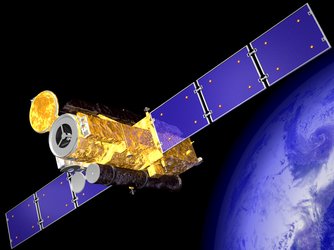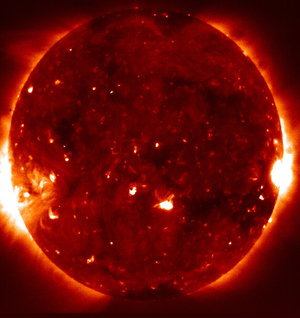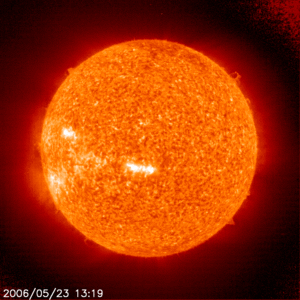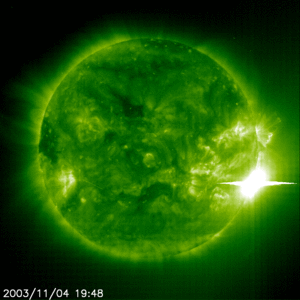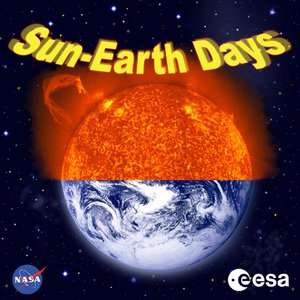Hinode’s solar data ready for Europe’s access
Since 27 May, Europe’s scientists have free access to spectacular data and images from Hinode, a Japan-led mission with ESA participation that studies the mechanisms that power the Sun’s atmosphere and cause violent eruptions.
This free access is now possible thanks to the opening of the Hinode Science Data Centre in Norway, developed and run by the Institute of Theoretical Astrophysics at the University of Oslo on behalf of ESA and the Norwegian Space Centre. It is part of ESA and Norway’s joint contribution to this solar mission.
The other part of the joint contribution to Hinode consists of ground station coverage through the SvalSat downlink station at Svalbard, which nearly quadruples the data rate and thus significantly increases Hinode’s science return. Svalsat is the only station in the world that can receive Hinode’s data during each of its 15 daily orbits.
“Our European solar science community is extremely strong. We have several space missions with ESA leadership, or strong European participation, which are producing outstanding results about the Sun and its interaction with the planetary environment,” says Bernhard Fleck, ESA’s SOHO and Hinode Project Scientist.

“When ESA, in a joint venture with Norway, decided to contribute to Hinode, it was to broaden the possibilities for European scientists to participate in this exciting new mission and at the same time increase the science possibilities for the worldwide scientific community,” he continues.
In exchange for ESA’s and Norway’s contribution to the mission, European scientists have been guaranteed free access to the Hinode data by the Japan Aerospace Exploration Agency (JAXA).
“No doubt European scientists will make great use of this data and will produce excellent new science about our daylight star,” concludes Fleck.
The quality of data now available through the Hinode Science Data Centre can be appreciated in spectacular movies of the Sun, obtained by the XRT X-ray telescope on board, made public on 27 May by the National Astronomical Observatory of Japan (NAOJ).
The first X-ray movie was obtained between January and April 2007. It shows the medium-term evolution of the dynamic solar corona. The corona is a portion of the solar atmosphere that extends for millions of kilometres into space and is much hotter than the solar surface – a puzzle still not completely understood by scientists.

The second movie, obtained on 16 March 2007, provides a close-up view of X-ray-bright points in what is believed to be a quiet region of the Sun’s surface. The high resolution of the XRT instrument helped scientists see that these X-ray-bright points – widely distributed - are actually ‘loop’ structures demonstrating intense activity.
“Data like this, being gathered by Hinode since it started operating in October 2006, is a treasure chest for our scientists,” says Stein Vidar Hagfors Haugan, Executive Director of the data centre. “With the archiving system developed in our data centre, innovative in terms of contextual searching capability and speed, we believe we are providing a great contribution to maximising the scientific return of this new exciting mission.”
Notes for editors
Hinode is a Japanese mission developed and launched by ISAS/JAXA, with NAOJ as domestic partner and NASA and STFC (former PPARC, UK) as international partners. It is operated by these agencies in co-operation with ESA and the Norwegian Space Centre.
For more information:
Stein Vidar Hagfors Haugan, Executive Director, Hinode Science Data Centre Europe
Email: s.v.h.haugan @ astro.uio.no
Bernhard Fleck, ESA SOHO and Hinode Project Scientist
Email: bfleck @ esa.nascom.nasa.gov















 Germany
Germany
 Austria
Austria
 Belgium
Belgium
 Denmark
Denmark
 Spain
Spain
 Estonia
Estonia
 Finland
Finland
 France
France
 Greece
Greece
 Hungary
Hungary
 Ireland
Ireland
 Italy
Italy
 Luxembourg
Luxembourg
 Norway
Norway
 The Netherlands
The Netherlands
 Poland
Poland
 Portugal
Portugal
 Czechia
Czechia
 Romania
Romania
 United Kingdom
United Kingdom
 Slovenia
Slovenia
 Sweden
Sweden
 Switzerland
Switzerland




























